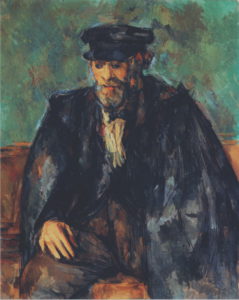R951 – Le Jardinier Vallier vu de face ; Le Marin 1902-1906 (FWN545)
Pavel Machotka
(Cliquer sur l’image pour l’agrandir)
It is inevitable that a painter will project something of himself into at least some of his portraits, and we are justified in seeing an image of Cézanne’s own age in the late portraits of Vallier and the various seated peasants. In no painting does the projection seem clearer than in the portrait called Le Marin—for which Vallier is also assumed to have served as model[1]–so heavy and formless is the body and so unfocused the expression, therefore so inviting of projections. The pose can be seen clearly enough: Vallier sits with legs splayed, back bent, one hand on the thigh, the other hidden under the cloak; but the effect is uncanny and the meaning of his pose—seemingly tired but self-affirming—hard to fathom. Cézanne’s touch is no less mysterious, being overworked in a way we have not seen before; in the head and coat, as far down as the hand, the paint accumulates to the point of granularity in the outlines and at the edges. The accumulation is easily explained technically—it results from liquid paint being applied repeatedly over a surface laid down in previous sessions—but hard to understand aesthetically. It may indicate an impatience with finding the contour, an expressive decision to introduce ambiguity, or a stubborn affirmation of the sitter’s substance – and perhaps the last of these is the most likely. It is in any case the decisive painting that makes the picture so deeply moving, so simply convincing, as an image of old age; it is in a way a masculine version of La Vieille au chapelet, but less demonstrative, technically more innovative, and in color more alive.
[1] See Rewald, PPC, vol. 1, p. 557, for this identification and for evidence of Cézanne’s intention to complete the eyes.
Source: Machotka, Cézanne: the Eye and the Mind.


